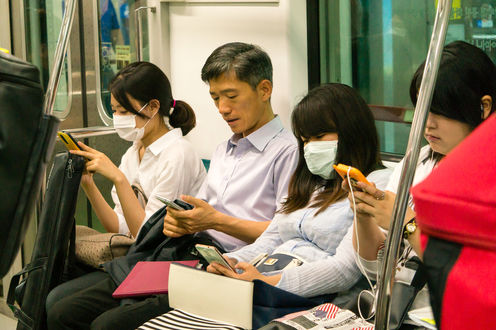
Twelve years ago the world was threatened by an outbreak of a new coronavirus called SARS (severe acute respiratory syndrome). SARS infected more than 8,000 people and killed one in ten of those infected.
In 2012 and 2013, a second coronavirus emerged in Saudi Arabia and was named MERS (Middle East respiratory syndrome). The MERS virus is a beta-coronavirus (MERS-CoV), which belongs to the same family as SARS but has some novel biological features.
Populations of cave bats in the Arabian peninsula appear to be the MERS reservoir, and many camels in Saudi Arabia have been infected. It is presumed that the virus was transmitted from camels to humans. Human-to-human transmission is not common, and seems to require very close contact.
Almost 1,300 people have been infected with MERS in Saudi Arabia and other countries, and 458 people have died. Since 2013, cases in 25 other countries have been linked to travellers returning from the Arabian Peninsula. Of these, the current South Korean outbreak is the largest.
MERS in South Korea
The latest MERS outbreak began last month when an infected traveller returned to Korea after visiting Saudi Arabia and Bahrain. He visited four hospitals before he was diagnosed on May 20. By June 16, 154 people had been infected in South Korea and 19 had died.
The South Korean government was initially hesitant in its response but soon imposed major quarantine measures. More than 2,000 schools and universities were temporarily closed, and about 5,000 people were isolated in their homes or in hospitals in an attempt to control the spread of the epidemic.
The South Korean health authorities have been assiduous in identifying all the contacts of every case and isolating the contacts for 14 days – the maximum incubation period for the virus. Some have suggested the quarantine measures were more aggressive than required, but they have worked to slow the spread of the disease.
While MERS initially spread rapidly in South Korea, the fatality rate so far is about 10%, which is much lower than the 40% fatality rate of the Saudi outbreak.
How does it spread?
The MERS coronavirus seems to be transmitted by respiratory droplets through close contact with infected people who cough or sneeze. But the possibility of infection through skin contact cannot be excluded.
Most of the deaths in South Korea have been in older patients who were in hospital for treatment of other illnesses. Overcrowding, poor ventilation and the use of ventilators in undiagnosed patients may have helped spread the disease.
The South Korean infections have resulted from very close personal contact with infected hospital patients. There has been no transmission through casual contact in community settings. This is very different from other contagious respiratory infections such as influenza, where transmission in social settings is common.
The main symptoms of MERS are fever, cough, and shortness of breath. In the Middle East outbreak, some patients went on to develop renal failure.
There is no antibiotic treatment or vaccine for MERS. But there is some evidence that plasma infusions from recovered patients were effective in the SARS epidemic, and this treatment is being tried on an experimental basis in South Korea.
In 2014, a compound called K22 was trumpeted as a possible treatment for SARS and MERS, but there have been no reports of successful clinical trials.
Avoiding MERS
The World Health Organization has not recommended any travel restrictions in relation to the MERS epidemic. Avoiding contact with people who have respiratory infections – and are coughing or sneezing and have a fever – is the key to protection. Wash your hands with soap after contact in social situations.
There is no specific risk to Australia at this stage, because the South Korean outbreak has been limited to contact with people infected in hospitals. As in the Middle East MERS outbreak, there seems to be a very low risk of person-to-person transmission in community settings.
There was, however, concern in 2013 and 2014 that MERS could spread during the Hajj, when around two million Muslims visit Saudi Arabia for the great pilgrimage. It may be necessary for Australia to again set up a special system to track pilgrims returning from the Hajj this September.
Charles Watson does not work for, consult to, own shares in or receive funding from any company or organisation that would benefit from this article, and has no relevant affiliations.
